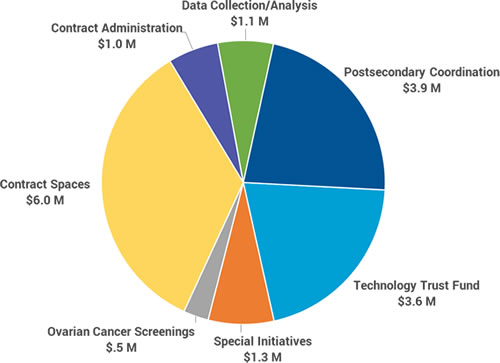CPE Budget Overview
The Council’s agency budget is comprised of five spending categories: 1) agency operations; 2) student aid and assistance; 3) technology and academic support; and 4) initiatives related to research and economic development.
2019-20 CPE Agency Budget

Postsecondary Education Funding Overview
The primary way that Kentucky finances its public postsecondary system and supports the teaching, research, and public service missions of individual colleges and universities is by appropriating state General Funds for institutional operations. These funds, along with tuition and fee revenue, support education and general (E&G) expenditures on campus, including faculty and staff salaries, fringe benefits, student financial aid, utilities, building maintenance, libraries, student support services, and numerous other operating expenses. When available, these funds also finance strategic initiatives consistent with mandates of House Bill 1 (1997).
Distribution of Kentucky's General Fund Appropriations, 2018-20 Biennium

Source: Commonwealth of Kentucky 2018-20 Executive Budget: Budget in Brief.
Performance Funding Overview
In 2017, the Postsecondary Education Performance Funding Bill (KRS 164.092) passed the House and Senate with no changes and was signed into law by the Governor. The newly enacted legislation established, and codified in statute, two funding models for distributing postsecondary institution appropriations, one for the public universities and another for KCTCS institutions. The two models are similar in structure and function, but differ in terms of student success metrics included in the models.
Each model has three basic components:
- Student Success (35 percent of allocable resources distributed based on relative success in achieving student progression milestones and degree and credential production)
- Course Completion (35 percent of allocable resources distributed based on share of earned student credit hours)
- Operational Support (30 percent of allocable resources distributed in support of vital campus operations, services, and infrastructure related to student learning and success).
Distribution of Allocable Funds through the Performance Funding Model

Both models will be phased in over three years, beginning in fiscal year 2018-19. A hold harmless provision, which prevents the transfer of any state General Fund appropriations among institutions, is included in the first year. In the second and third year, the bill institutes one and two percent stop-loss provisions, which limit the amount of potential transfers among institutions in fiscal years 2019-20 and 2020- 21, respectively. Beginning in 2021-22, hold harmless and stop loss provisions will sunset, allowing 100 percent of allocable resources to be distributed as determined by the formula.
